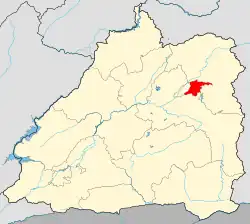Menghuan Subdistrict
勐焕街道 | |
|---|---|
 Location of the subdistrict region in Mangshi | |
 Menghuan Subdistrict Location in Yunnan | |
| Coordinates: 24°26′38″N 98°35′51″E / 24.444007°N 98.597476°E | |
| Country | People's Republic of China |
| Province | Yunnan |
| Prefecture | Dehong Dai and Jingpo Autonomous Prefecture |
| County-level city | Mangshi |
| Area | |
| • Total | 23.15 km2 (8.94 sq mi) |
| Population (2017) | |
| • Total | 171,195 |
| • Density | 7,400/km2 (19,000/sq mi) |
| Time zone | UTC+08:00 (China Standard) |
| Postal code | 678400 |
| Area code | 0692 |
Menghuan Subdistrict (simplified Chinese: 勐焕街道; traditional Chinese: 勐煥街道; pinyin: Měnghuàn Jiēdào) is an urban subdistrict in Mangshi, Yunnan, China.[1] As of the 2017 census it had a population of 171,195 and an area of 23.15-square-kilometre (8.94 sq mi).[2] It is the political, economic and cultural center of Mangshi City and Dehong Dai and Jingpo Autonomous Prefecture.
Administrative division
As of 2010, the subdistrict is divided into 11 communities:
- Xinanli Community (西南里社区)
- Dongbeili Community (东北里社区)
- Tuanjie Community (团结社区)
- Xincun Community (新村社区)
- Jinhua Community (锦华社区)
- Jianguo Community (建国社区)
- Bingwu Community (丙午社区)
- Sankeshu Community (三棵树社区)
- Jiaolin Community (胶林社区)
- Bingmen Community (丙门社区)
- Chengxi Community (城西社区)
Etymology
In Dai language, "Mangshi" is called "Menghuan", which means "the city of dawn". It is said that Gautama Buddha came here just at dawn, so he named it.
History
In 2007, Menghuan Subdistrict separated from Mangshi Town.
Geography
Mangjiu Reservoir (芒究水库) is a reservoir and the largest body of water in the subdistrict. It is very popular for boating, fishing and camping and is home to many residents from other areas of the province during the summer months.
Education
Dehong Vocational College is located in the subdistrict.
- Secondary school: Dehong No. 1 High School for Nationalities
Economy
The economy is supported primarily by commerce.
References
- ↑ 保护传承傣族传统银饰. youth.cn (in Chinese). 2017-04-28.
- ↑ 勐焕街道概况. dhms.gov.cn (in Chinese). 2018-03-26.